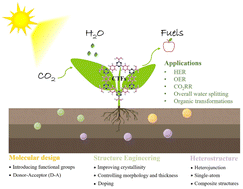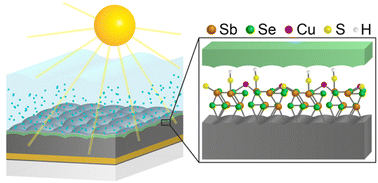Themed collection Emerging Materials for Solar Energy Harvesting

Introduction to emerging materials for solar energy harvesting
Guest Editors Joel M. R. Tan, Frank E. Osterloh, and Lydia Wong introduce this Journal of Materials Chemistry A themed collection on emerging materials for solar energy harvesting.

J. Mater. Chem. A, 2024,12, 6795-6796
https://doi.org/10.1039/D4TA90038C
Recent progress and perspectives on heteroatom doping of hematite photoanodes for photoelectrochemical water splitting
Over the past few decades, extensive research on photoelectrochemical (PEC) water splitting has been conducted as a promising solution to meet the increasing demand for cleaner and renewable energy in a sustainable manner.

J. Mater. Chem. A, 2023,11, 24551-24565
https://doi.org/10.1039/D3TA04520J
Recent advances in photocatalyst sheet development and challenges for cost-effective solar hydrogen production
This article presents progress and challenges in the development of photocatalyst sheets for scalable efficient production of renewable hydrogen via water splitting reaction.

J. Mater. Chem. A, 2023,11, 20470-20479
https://doi.org/10.1039/D3TA04353C
Cu2ZnSnS4 monograin layer solar cells for flexible photovoltaic applications
This review provides a comprehensive overview of the significant advancements made in CZTS monograin powder technology and its applications in flexible solar cells over the past decade.

J. Mater. Chem. A, 2023,11, 23640-23652
https://doi.org/10.1039/D3TA04541B
Strategies to improve the photocatalytic performance of covalent triazine frameworks
Various strategies for improving the photocatalytic performance of covalent triazine frameworks, including molecular design, structural regulation and the creation of heterostructures, are summarized.

J. Mater. Chem. A, 2023,11, 21470-21497
https://doi.org/10.1039/D3TA04472F
Prebaking of an SnS source with sulfur for achieving higher photovoltaic performance in VTD-SnS thin films for solar cells
We prepared a prebaked (SnS + S) source absorber which results in suppressing the deep level and interface defects. The device showed a 42% enhancement in the performance compared to the reference absorber-based device without prebaking.

J. Mater. Chem. A, 2024,12, 3265-3275
https://doi.org/10.1039/D3TA05204D
Efficiency enhancement and doping type inversion in Cu2CdSnS4 solar cells by Ag substitution
Silver substitution on Cu2CdSnS4 solar cells improves device performance at small doping concentrations. Structural and properties changes are induced with higher silver alloying amounts.

J. Mater. Chem. A, 2024,12, 2673-2679
https://doi.org/10.1039/D3TA04529C
InCl3-modified SnO2 as an electron transporting layer for Cd-free antimony selenide solar cells
We demonstrated InCl3 modified SnO2 as ETL in Sb2Se3 solar cells. InCl3 post-treatment blocked the downward diffusion of Se and improved the quality of the SnO2/Sb2Se3 heterojunction. Thus, a Cd-free Sb2Se3 solar cell achieved a PCE of 5.52%.

J. Mater. Chem. A, 2023,11, 16963-16972
https://doi.org/10.1039/D3TA03358A
How carbon contamination on the photocatalysts interferes with the performance analysis of CO2 reduction
Carbon contamination on the photocatalysts intereferes the performance analysis of photocatalytic carbon dioxide (CO2) reduction reaction (CO2RR).

J. Mater. Chem. A, 2023,11, 10149-10154
https://doi.org/10.1039/D3TA00834G
Sn-assisted heteroepitaxy improves ZnTiN2 photoabsorbers
Ambient temperature growth on Si produces a polycrystalline ZnTiN2 film while Sn-assisted growth on sapphire at elevated temperature results in a single-crystal-like ZnTiN2 film with significantly reduced sub-bandgap absorption.

J. Mater. Chem. A, 2024,12, 4544-4554
https://doi.org/10.1039/D3TA06200G
Covalency-aided electrochemical CO2 reduction to CO on sulfide-derived Cu–Sb
Sulfide-derived catalysts tend to be more selective to HCOO− with suppression of CO production. We found that sulfur-doped Cu–Sb breaks the trend with improved CO selectivity.

J. Mater. Chem. A, 2024,12, 1840-1851
https://doi.org/10.1039/D3TA04777F
All-in-one ultrathin nanoporous ZnIn2S4 with ameliorated photoredox capability: harvesting electron–hole pairs in cooperative hydrogen and benzaldehyde production
All-in-one ultrathin porous ZnIn2S4 toward photocatalytic water reduction and benzyl alcohol oxidation for the co-production of hydrogen fuels and value-added benzaldehyde.

J. Mater. Chem. A, 2024,12, 1453-1464
https://doi.org/10.1039/D3TA04204A
Charge transfer enhancement at the CZTS photocathode interface using ITO for efficient solar water reduction
The study employs an ITO layer to enhance CZTS photocathodes for water splitting, resulting in improved photocurrent, onset potential, and stability through phosphate ion removal and In–Pt/Sn–Pt interactions on the ITO surface.

J. Mater. Chem. A, 2023,11, 26543-26550
https://doi.org/10.1039/D3TA05227C
Stability and synthesis across barium tin sulfide material space
The underexplored Ba–Sn–S phase space is explored at various temperatures and cation ratios with combinatorial sputtering, crystallizing rocksalt-derived phases, Ba2SnS4, and Ba7Sn5S15. These findings are supported by DFT computed phase diagrams.

J. Mater. Chem. A, 2023,11, 24948-24958
https://doi.org/10.1039/D3TA04431A
Photoelectrochemical behaviour of photoanodes under high photon fluxes
Fe2O3 and BiVO4 photoanodes were studied under exceptionally high irradiation conditions (up to 358 kW m−2) and the photoelectrochemical performance and degradation rates under such conditions were quantified.

J. Mater. Chem. A, 2023,11, 23895-23908
https://doi.org/10.1039/D3TA05257E
Low-cost and high-performance selenium indoor photovoltaics
We replace high-cost Au with low-cost Cu as the electrode that greatly reduces the cost of Se photovoltaics. The resulting Se cells achieve an efficiency of 10.4% under indoor illumination at 500 lux.

J. Mater. Chem. A, 2023,11, 23837-23843
https://doi.org/10.1039/D3TA04530G
Efficiency boosting in Sb2(S,Se)3 solar cells enabled by tailoring bandgap gradient via a hybrid growth method
A novel hybrid growth method involving the first-stage hydrothermal deposition (HTD) process and the second-stage vapor transport deposition (VTD) enables an optimal bandgap gradient in Sb2(S,Se)3, ultimately leading to a remarkable efficiency improvement in Sb2(S,Se)3 solar cells.

J. Mater. Chem. A, 2023,11, 23071-23079
https://doi.org/10.1039/D3TA05489F
Air-stable bismuth sulfobromide (BiSBr) visible-light absorbers: optoelectronic properties and potential for energy harvesting
Phase-pure thin films of BiSBr are shown to have an optical efficiency limit of 43.6% under indoor lighting, with improved environmental and photo-stability over lead-halide perovskites, and have band positions well suited to a range of charge transport layer materials.

J. Mater. Chem. A, 2023,11, 22775-22785
https://doi.org/10.1039/D3TA04491B
First-principles study of intrinsic and hydrogen point defects in the earth-abundant photovoltaic absorber Zn3P2
The shallow VZn acceptors are proposed as the source for p-type doping in the Zn3P2 solar absorber. Not only VZn but also deep-level defects PZn and Pi have increased concentrations in non-stoichiometric, P-rich Zn3P2.

J. Mater. Chem. A, 2023,11, 20592-20600
https://doi.org/10.1039/D3TA03697A
Interfacial defect healing of In2S3/Sb2(S,Se)3 heterojunction solar cells with a novel wide-bandgap InOCl passivator
A novel wide-bandgap InOCl passivator incorporated between In2S3 buffer layer and Sb2(S,Se)3 absorber enables high performance fully environment-friendly solar cells.

J. Mater. Chem. A, 2023,11, 19914-19924
https://doi.org/10.1039/D3TA01736B
Decoupling the contributions of industrially relevant conditions to the stability of binary and ternary FeNi-based catalysts for alkaline water oxidation
Decoupling the industrially relevant conditions simulating the electrolytic conditions in alkaline water electrolysers reveals a larger stability decay for ternary FeNiCr hydroxides as a promoted catalyst for water oxidation compared to binary FeNi.

J. Mater. Chem. A, 2023,11, 19418-19426
https://doi.org/10.1039/D3TA03905F
SbSeI and SbSeBr micro-columnar solar cells by a novel high pressure-based synthesis process
SbSeX (X = I, Br) chalcohalides constitute a new family of earth-abundant wide-bandgap materials suitable for PV applications. Development of a new versatile and scalable synthesis methodology based on high pressure annealing.

J. Mater. Chem. A, 2023,11, 17616-17627
https://doi.org/10.1039/D3TA03179A
Ni2FeS4 as a highly efficient earth-abundant co-catalyst in photocatalytic hydrogen evolution
Earth abundant Ni2FeS4 was used as a highly efficient co-catalyst for the hydrogen evolution reaction over TiO2, as an alternative to noble metal co-catalysts.

J. Mater. Chem. A, 2023,11, 17066-17078
https://doi.org/10.1039/D3TA02439C
Alkali element (Li, Na, K, and Rb) doping of Cu2BaGe1−xSnxSe4 films
Alkali elements (Li, Na, K, and Rb) were used as prospective p-type dopants for Cu2BaGe1−xSnxSe4 films to address the low hole carrier density, and associated changes in film properties were investigated.

J. Mater. Chem. A, 2023,11, 15336-15346
https://doi.org/10.1039/D3TA01494K
Interlayer modification and single-layer exfoliation of the Ruddlesden–Popper perovskite oxynitride K2LaTa2O6N to improve photocatalytic H2 evolution activity
Ethylamine-intercalated HxK2−xLaTa2O6N, further modified with a Pt cocatalyst, exhibited 60 times height photocatalytic activity for H2 evolution under visible light, as compared with the parent layered material.

J. Mater. Chem. A, 2023,11, 9485-9492
https://doi.org/10.1039/D3TA01387A
Solution phase treatments of Sb2Se3 heterojunction photocathodes for improved water splitting performance
The PEC performance of antimony selenide (Sb2Se3) is increased by removing oxide impurities from the surface using (NH4)2S etching solution and passivating dangling bonds with a CuCl2 solution treatment.

J. Mater. Chem. A, 2023,11, 8277-8284
https://doi.org/10.1039/D3TA00554B
About this collection
Guest edited by Professor Frank Osterloh (University of California, Davis), Dr Joel Tan (Nanyang Technological University), and Professor Lydia Helena Wong (Nanyang Technological University).
This special themed collection of Journal of Materials Chemistry A was published in collaboration with the ICMAT 2023 Symposium O in Singapore, focusing on emerging inorganic materials for solar energy conversion technologies. This includes photovoltaic devices, devices for CO2 and nitrogen activation, water splitting electrodes and photocatalysts, and related devices.